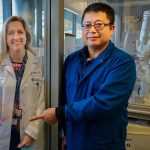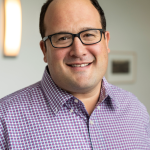
Funded by the Dick Vitale Pediatric Cancer Research Fund
We aim to develop a novel and effective therapy for a lethal pediatric brain cancer (diffuse midline glioma, DMG). No effective treatment for DMG currently exists. This cancer arises when a mutation appears in a gene called H3F3A, causing it to produce a toxic protein. The mutant protein makes cells grow unchecked, forming a tumor in an inaccessible brain region and eventually killing the patient. Each of our genes makes RNA—so-called messenger RNA (mRNA)—and the mRNA is then read in another part of the cell to make the protein encoded by that gene. The technology we use, called “antisense”, allows us to target the mRNA made from a gene, and either destroy it or change it. Either way, the toxic protein is no longer made, and because the tumor cells require it for growth, they stop growing and die or change into normal cells. Once our antisense drug is developed, it will be injected into the fluid surrounding the spinal cord, allowing it to reach the brain tumor. Another gene, called H3F3B, encodes the same protein as H3F3A, so our method will get rid of the defective protein but not the normal protein. Therefore, the drug should not harm normal tissues outside the tumor. We will design, test, and perfect our antisense approach using cells derived from DMG tumors, and mouse models of this brain cancer. If this project is successful, the resulting antisense drug will undergo further safety tests, in preparation for clinical trials involving DMG patients.

Bob Bast Translational Research Grant *
Our lab is developing treatments for human cancers by engineering immune cells called “T cells” to recognize and kill tumor cells. Engineered T cells can eradicate tumors in patients with blood cancers, like leukemia and lymphoma. However, they have had limited success so far against more common “solid tumors”, like breast and lung cancer, which are responsible for the majority of cancer deaths. Solid tumors can evade attack by inducing T cells to lose function and become “exhausted.” Strategies to preserve T cell function, thus, are needed to extend the success of engineered T cell therapy to solid tumors. Our lab has developed a mouse model of lung cancer that mimics human tumor development and patient response to therapy. In this model, T cells engineered to overexpress a gene that promotes T cell function dramatically eliminated tumors in ~50% of mice. Based partly on these results, a clinical trial is being planned to test whether these T cells are safe and effective in patients. However, our data show that tumors still progress in ~50% of mice. We will use the mouse model we developed to define why tumors progress in a subset of mice and test different combination treatments to identify regimens that improve T cell function and kill tumors most effectively. Working with Fred Hutch clinicians and industry partners, our goal is to translate the strategies that appear most effective in mouse models to the clinic to test their impact in patients.

Nick Valvano Translational Research Grant *
Previously, the main treatments for cancer patients were surgery, radiation, and medicines with many unpleasant side-effects. The discovery that there are ways to turn our own defense system against cancer became a medical revolution. In some patients, this new treatment led to miracle cures that had never been seen before. The discovery was so incredible, it won a Nobel prize. Unfortunately, this new treatment does not work in as many patients as we would like. It is still a mystery why two people with the same cancer will respond differently to treatment, one patient might be cured and the other patient does not get better. This project is trying to figure out ways that will help doctors know who will be cured and who will not get better with this new treatment. We are developing a blood test to predict who will be cured before treatment begins. For those patients that are not likely to be cured, we are doing experiments to develop a medicine that can be added to the treatment in order to make the treatment cure many more patients.

Funded by Matthew Ishbia and the Dick Vitale Pediatric Cancer Research Fund
Childhood cancers of developing muscle are some of the most difficult to treat childhood cancers. Therapy has not significantly changed in the past 20 years and there isn’t even a meaningful new treatment being considered. Currently, even after the most intensive therapy possible, a third of these tumors will return and take the life of a child or young adult. We have taken a new approach using state-of-the-art methods to identify what we hope will be more targeted and less toxic treatments that yield better outcomes. We have already identified three new therapeutic avenues that we will test. The first is to ask if the abnormal gene that drives this disease, called PAX3-FOXO1, is a good drug target. We engineered the gene to be sensitive to a derivative of a known drug. While we can’t do this in kids, it allows us to ask what would happen if we had a drug? Second, we found that PAX3-FOXO1 turns on a small number of other genes, and we already have drugs that can target some of these. Third, we identified other possible drug targets that PAX3-FOXO1 recruits. We will test if these are key to causing cancer and if they would be good drug targets. We believe that our comprehensive approach gives us the best chance in the past 30 years to change the lives of these children with cancer, and to identify drugs or drug combinations that will be less toxic and yield better outcomes for these patients.

Funded by the Stuart Scott Memorial Cancer Research Fund
We believe that the immune system in patients with a precursor condition to multiple myeloma (a cancer in the bone marrow) allows the disease to progress (worsen) into more serious disease. Our project aims to find immune biomarkers that predict disease progression and identify patients who will likely progress early to treat the most at-risk patients before they become symptomatic. These markers may include changes in the number or type of immune cells or changes in the way those cells work. We will also examine how patients’ immune systems change in response to a new treatment that targets immune cells. We will use DNA and RNA sequencing and spatial imaging to investigate single cells from the bone marrow. We will gain a detailed picture of how the immune system supports or fights the tumor. This work will support the development of new treatments that may slow or stop disease progression.

Immunotherapy has transformed cancer therapy and positively impacted the lives of many patients. However, despite these advances, there remain barriers to the success of immunotherapy, and a majority of patients do not get better from immunotherapy. Unfortunately, soft tissue sarcomas are among the cancers which do not respond well to current immunotherapies, and the survival rate for these rare and difficult-to-treat cancers has barely improved for many years. Therefore, more research is needed to extend the benefits of immunotherapy to sarcoma patients.
The past decade has witnessed a big increase in research on natural killer (NK) cells. NK cells are a part of the immune system and are able to rapidly attack bacteria and cancer cells. Despite their ability to kill tumor cells, success with NK cells in cancer patients has hit roadblocks, in part because these cells lose killing capacity quickly, likely so the body can control them. This proposal seeks to understand how this exhaustion of NK cells can be overcome to better fulfill the promise of NK immunotherapy. We will block a novel receptor (TIGIT) on NK cells since this receptor is consistently upregulated on NK cells. We will use a diverse approach, including mice and human sarcoma samples. Then, we will pilot our new immunotherapy approach using NK cells and TIGIT blockade to release the brakes in a first-in-dog clinical trial for dog patients with soft tissue sarcomas. Cancer is a leading cause of death in dogs, as it is for humans.

Nick Valvano Translational Research Grant *
Brain tumors are the number one cause of pediatric cancer deaths. And despite advances in treatment, children in remission have both the constant worry of their tumor returning, plus long term (often delibitating) treatment-induced side effects. . As new treatments are developed, there is an urgent need to better monitor treatment response.
Due to their location, the most common tool for monitoring pediatric brain tumors is recurrent imaging ( such as a series of MRI imaging scans over time). While imaging can provide some information about current disease status in brain tumor patients, it can’t provide details on how the tumor has changed in response to therapy. To address this gap in technological capacity, our team has developed a less invasive blood test that can remove rare tumor cells and particles released by the tumor in brain tumor patients. This test requires less than a teaspoon of blood, which makes it ideal for pediatric patients. For this study, we will use our test on 60 pediatric cancer patients with gliomas and medulloblastomas, in order to detect and monitor the these biomarkers in the blood, and watch for changes to their levels throughout treatment. At the end of this study, we then plan to test our techology in multi-center clinical trials. Our long-term goal is to use tumor biomarkers in blood to more rapidly identify when brain cancer patients need to be retreated, which we hope can in turn be used to accelerate and improve therapeutic interventions.

Co-funded by the Dick Vitale Gala, and WWE in honor of Connor’s Cure
Dr. Jun Qi is a synthetic organic chemist and chemical biologist who has developed small molecules and pioneered a novel chemical strategy in which small molecule therapeutics can be designed to destroy specific proteins within a cell, as opposed to suppressing enzymatic function. Dr. Mariella Filbin is a physician scientist specializing in pediatric neuro-oncology with clinical and scientific interests converging upon pediatric brain cancers, in particular, diffuse intrinsic protein glioma (DIPG) which is universally fatal. Dr. Filbin has used patient-derived models to identify a potential DIPG-specific target for Dr. Qi’s protein degrader technology. They will work together to overcome challenges in childhood brain cancer treatment, such as toxicity and blood-brain-barrier (BBB) penetration. This exciting study has two broad objectives:
- To define the mechanism by which the cancer dependent protein is driving DIPG formation and growth;
- To yield optimized drug compounds suitable for preclinical study and translation to clinical trials in DIPG.
By working together as team, Drs. Qi and Filbin will cultivate a symmetrical relationship in which chemistry will be used to clarify the biology; and biology will be used to guide the small molecule design and development. By combining their complementary skill sets in chemistry, chemical biology and cancer biology, their joint efforts will result in the preclinical validation of eliminating the target genes and ideally the development of a clinical trial using this novel strategy for DIPG to achieve the bench-to-bedside translation of their research.

Co-funded by the Dick Vitale Gala, and WWE in honor of Connor’s Cure
DIPG is a universally fatal brain tumor that occurs in children. Thanks to extensive research, we now understand the biologic causes of DIPG, but no one has found an effective way to treat the disease. Patients receive radiation to slow the disease and relieve symptoms, but they almost all die within two years of diagnosis. We have found that a target known as GD2 is highly expressed on DIPG. GD2 can be targeted with an antibody that is FDA approved to treat another type of cancer. When the antibody finds its target, it recruits immune cells to “eat” the cancer cells. Here, we propose combining anti-GD2 with another antibody that stimulates the immune system to “eat” cancer cells (anti-CD47). Because antibodies cannot reach the brain when given in the blood, we will deliver these two antibodies by direct injection into the tumor. Our main goal is to test this approach in mouse models of DIPG to see if it is safe and effective. This will hopefully serve as the basis for a clinical trial for children with DIPG. We will also explore alternative and complementary ways to attack the tumors.













